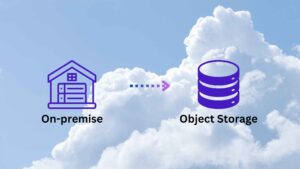
In today’s data-driven world, organizations are constantly seeking solutions to manage and store their ever-growing volumes of information. While on-premises storage has traditionally been the go-to option, object storage has emerged as a compelling alternative, offering remarkable scalability, accessibility, and cost-effectiveness.
Migrating from on-premises storage to object storage can be a complex undertaking, requiring careful planning and execution. This comprehensive guide will delve into the key steps involved in this process, ensuring a smooth and successful transition to the cloud.
Assessing Your Current Storage Environment
The first step in embarking on this migration journey is to thoroughly assess your current storage environment. This involves:
-
Identifying Data Types: Determine the types of data you store, such as unstructured data (e.g., images, videos, logs), structured data (e.g., databases), and semi-structured data (e.g., JSON, XML).
-
Quantifying Data Volume: Accurately estimate the amount of data you currently store, considering all data types and sources.
-
Understanding Data Usage Patterns: Analyze how your data is currently being used, including access patterns, frequency of access, and data retention requirements.
Evaluating Object Storage Providers
Once you have a clear understanding of your storage needs, it’s time to evaluate potential object storage providers. Consider factors such as:
-
Storage Classes: Assess the availability of storage classes that align with your data access and retention requirements.
-
Data Replication: Evaluate the provider’s data replication capabilities to ensure data redundancy and disaster recovery.
-
Data Management Tools: Explore the availability of built-in data management tools to streamline data organization, access, and security.
-
Pricing Models: Analyze the provider’s pricing structure, considering factors like storage capacity, data transfer costs, and access fees.
Planning Your Migration Strategy
After selecting an object storage provider, carefully plan your migration strategy. This involves:
-
Choosing a Migration Tool: Evaluate data migration tools that can automate the transfer process, reducing manual effort and minimizing errors.
-
Minimizing Downtime: Identify potential downtime periods and determine strategies to mitigate their impact on business operations.
-
Establishing Data Transfer Schedule: Develop a schedule for transferring data in manageable chunks to avoid overwhelming network resources.
Testing Your Migration Plan
Before embarking on the actual migration, thoroughly test your plan to ensure its effectiveness. This includes:
-
Testing Data Migration Tool: Validate the functionality of the chosen data migration tool by transferring a small subset of data.
-
Verifying Data Transfer Accuracy: Confirm that the transferred data is accurate and complete by comparing it to the original data.
-
Identifying and Resolving Issues: Proactively identify and address any potential issues that arise during the testing phase.
Initiating the Migration Process
Once testing is complete, commence the migration process. This involves:
-
Transferring Data: Begin transferring data from your on-premises storage to the object storage provider using the chosen method.
-
Monitoring Migration Progress: Continuously monitor the migration progress, tracking data transfer rates and identifying any bottlenecks.
-
Addressing Issues Promptly: Promptly address any issues that arise during the migration process to minimize delays and disruptions.
Verifying and Updating Data
Upon completion of the migration, meticulously verify the transferred data:
-
Data Integrity Check: Ensure the integrity of the migrated data by comparing it to the original data.
-
Data Access Validation: Verify that all migrated data can be accessed and utilized as expected.
-
Configuration Updates: Update any configurations or settings to ensure seamless access and usage of the migrated data.
Optimizing and Maintaining Object Storage
After successful migration, optimize your object storage environment for efficient operation:
-
Monitoring Storage Usage: Regularly monitor storage usage patterns to identify potential capacity issues or cost overruns.
-
Data Retention Policies: Implement data retention policies to manage data lifecycle and optimize storage costs.
-
Leveraging Data Management Tools: Utilize data management tools to organize, secure, and optimize data stored in the object storage.
Conclusion
Migrating from on-premises storage to object storage can transform your data management approach, offering enhanced scalability, accessibility, and cost-effectiveness. By carefully assessing your storage needs, evaluating object storage providers, planning your migration strategy, testing your plan, initiating the migration, verifying and updating data, and optimizing and maintaining object storage, you can ensure a smooth and successful transition that empowers your organization to harness the full potential of cloud-based data storage.
